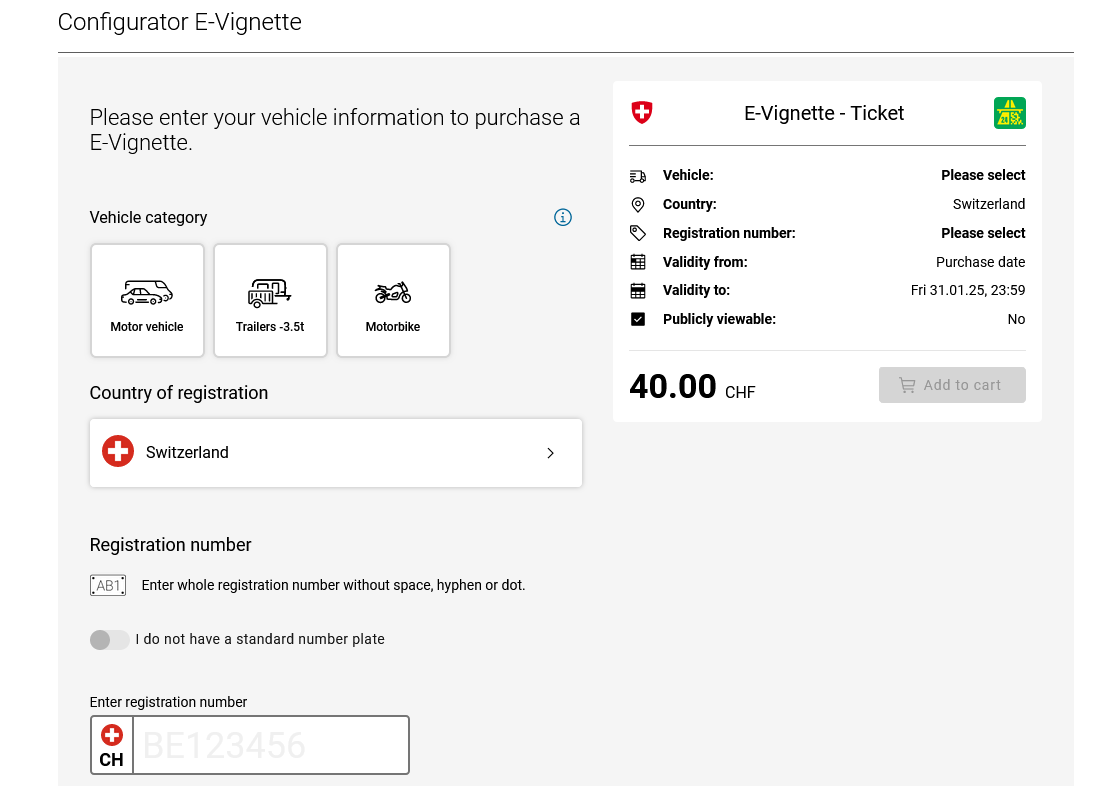The Swiss Motorway Vignette: Navigating the Essentials of Swiss Roadways
Switzerland, known for its picturesque landscapes and seamless transportation systems, has long maintained a unique approach to motorway usage. Central to this is the Swiss motorway vignette, a mandatory toll sticker that grants vehicles access to the country’s vast network of highways. Traditionally, this vignette is a physical sticker displayed on the windshield, an annual pass that symbolizes compliance and mobility.
However, the Swiss government’s recent shift to electronic vignettes heralds a new era in convenience and efficiency. This article delves into the vignette’s history, its current digital transformation, and the caution needed amidst the rise of unofficial resellers.
History and Origin of the Swiss Vignette
Early Days and Adoption
On February 26, 1984, the Swiss electorate endorsed, with 53% in favor, the introduction of a new fee for the use of national highways, taking the form of an annual vignette. Initially intended to last for a decade, this sticker became officially mandatory on January 1, 1985, with a cost of 30 Swiss Francs. As the ten-year period concluded, the Federal Council sought to make this levy a permanent fixture and presented the issue to the people. In February 1994, a substantial 68.5% of Swiss voters agreed to extend the vignette’s validity. Subsequently, from 1995 onwards, the cost of the vignette was adjusted to 40 Swiss Francs, reflecting the ongoing commitment of the Swiss populace to maintain and support their national roadways.
The Swiss vignette emerged as a practical solution for funding road maintenance without resorting to toll booths that could disrupt traffic flow. Introduced as a compulsory adhesive sticker, it quickly became a familiar sight on local and foreign vehicles alike, navigating the Alpine nation’s roads.
Evolution of the Vignette
Annually, motorists would replace the old sticker with a new one, marked with the year’s number, signifying their contribution to the upkeep of some of Europe’s most well-maintained highways. This ritual, while straightforward, was not without its minor inconveniences — from the meticulous removal of the previous year’s vignette to ensuring the new one was properly affixed.
In 2013, a pivotal moment in the history of Swiss transportation unfolded as the populace voted on a proposed increase in the motorway vignette’s cost. The Swiss, known for their direct democratic traditions, were presented with a modification to the vignette law that suggested elevating the annual fee from 40 CHF to 100 CHF. This significant hike was coupled with an introduction of a two-month vignette, priced at 40 CHF, particularly targeting tourists. The rationale behind this amendment was clear: additional revenue was needed to finance the operation, maintenance, and expansion of approximately 400 km of cantonal roads, which were to be integrated into the national highway network.
However, the Swiss citizens, exercising their democratic rights, decided against the increase, maintaining the vignette’s price at 40 CHF. This decision underscores the importance of public consensus in Swiss policymaking and reflects the nation’s meticulous approach to balancing infrastructure development with financial prudence.
The Vignette in Modern Times
Transition to Digital
Acknowledging the digital age and the need for greater convenience, the Swiss authorities introduced the e-vignette. At the same price of 40.00 CHF, valid until January 31st of the following year, this digital counterpart aims to simplify the process while maintaining the revenue stream for highway maintenance.
Unofficial Resellers
However, this innovation has been met with challenges. Numerous unofficial websites, such as vintrica.com and vignettesswitzerland.com, offer the vignette at marked-up prices. While not illegal, as per the Swiss customs office, these practices prey on uninformed consumers, emphasizing the importance of purchasing from the official source, www.e-vignette.ch, or sticking to the physical vignette.
Detailed Examination of the Vignette System
Financial Implications and Benefits
The vignette system, by requiring a flat annual fee, distributes the cost of highway maintenance across all users, fostering a high-quality road network. Its relatively low price compared to toll systems in other countries makes it an economical choice for frequent travelers.
Impact on Tourism and Traffic
For tourists, the vignette is a gateway to Switzerland’s scenic routes and efficient highways. It ensures that visitors contribute fairly to the infrastructure they use, while also experiencing the convenience of toll-free travel once inside the country.
The Role of Technology and Future Prospects
The shift towards an electronic vignette system reflects broader trends in transportation and governance. As technology evolves, so too may the vignette, potentially incorporating real-time data or variable pricing based on usage or environmental factors.
Summary Table
| Aspect | Detail |
|---|---|
| Cost | 40.00 CHF per year |
| Validity | Until January 31st of the following year |
| Purchase Options | Physical sticker or electronic via e-vignette.ch |
| Official Reseller | e-vignette.ch (40.00 CHF) |
| Unofficial Resellers | vintrica.com (44.00 CHF), vignettesswitzerland.com (52.95 EUR) |
The Road Ahead
The Swiss motorway vignette stands as a testament to the country’s commitment to quality infrastructure and user-friendly systems. While the introduction of the e-vignette marks a significant step forward, users must navigate this transition wisely, avoiding overpriced offers from unofficial sources. Whether opting for the traditional sticker or embracing the digital shift, the vignette remains a small yet significant part of the Swiss driving experience.
More informations : vignette.ch




